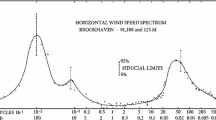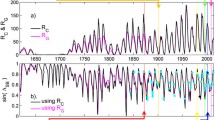Abstract
Previous analysis of magnetohydrodynamic-scale currents in high-speed solar wind near 1 AU suggests that the most intense current-carrying structures occur at electron scales and are characterized by average current densities on the order of \(1~\mbox{pA}/\mbox{cm}^{2}\). Here, this prediction is verified by examining the effects of the measurement bandwidth and/or measurement resolution on the analysis of synthetic solar wind signals. Assuming Taylor’s hypothesis holds for the energetically dominant fluctuations at kinetic scales, the results show that when \(\nu_{c}\gg \nu_{b}\), where \(\nu_{c}\) is the measurement bandwidth and \(\nu_{b} \approx 1/3~\mbox{Hz}\) is the break frequency, the average scale of the most intense fluctuations in the current density proxy is approximately \(1/\nu_{c}\), and the average peak current density is a weakly increasing function that scales approximately like \(\nu_{c}^{0.1}\).




Similar content being viewed by others
References
Abramowitz, M., Stegun, I.A. (eds.): 1972, Handbook of Mathematical Functions with formulas, Graphs, and Mathematical Tables, 10th edn., National Bureau of Standards, Washington.
Alexandrova, O., Saur, J., Lacombe, C., Mangeney, A., Mitchell, J., Schwartz, S.J., Robert, P.: 2009, Universality of solar wind turbulent spectrum from MHD to electron scales. Phys. Rev. Lett. 103, 165003.
Barakat, R.: 1961, Evaluation of the incomplete gamma function of imaginary argument by Chebyshev polynomials. Math. Comput. 15(73), 7.
Chen, C.H.K., Salem, C.S., Bonnell, J.W., Mozer, F.S., Bale, S.D.: 2012, Density fluctuation spectrum of solar wind turbulence between ion and electron scales. Phys. Rev. Lett. 109(3), 035001. DOI .
Cramér, H., Leadbetter, M.R.: 1967, Stationary and Related Stochastic Processes, Wiley, New York.
Cuyt, A., Petersen, V.B., Verdonk, B., Waadeland, H., Jones, W.B.: 2008, Handbook of Continued Fractions for Special Functions, Springer, New York.
Davies, R.B., Harte, D.S.: 1987, Tests for Hurst effect. Biometrika 74(1), 95. DOI .
Dietrich, C.R., Newsam, G.N.: 1997, Fast and exact simulation of stationary Gaussian processes through circulant embedding of the covariance matrix. SIAM J. Sci. Comput. 18, 1088. DOI .
Goldstein, M.L., Roberts, D.A., Matthaeus, W.H.: 1995, Magnetohydrodynamic turbulence in the solar wind. Annu. Rev. Astron. Astrophys. 33, 283. DOI .
Jones, W.B., Thron, W.J.: 1974, Numerical stability in evaluating continued fractions. Math. Comput. 28(127), 795. http://www.jstor.org/stable/2005701 .
Leamon, R.J., Smith, C.W., Ness, N.F., Matthaeus, W.H., Wong, H.K.: 1998, Observational constraints on the dynamics of the interplanetary magnetic field dissipation range. J. Geophys. Res. 103, 4775. DOI .
Lindgren, G.: 2013, Stationary Stochastic Processes: Theory and Applications, CRC Press, Boca Raton.
Lindquist, A., Picci, G.: 2015, Linear Stochastic Systems: A Geometric Approach to Modeling, Estimation and Identification, Springer, Berlin.
Papoulis, A.: 1984, Probability, Random Variables, and Stochastic Processes, 2nd edn., McGraw–Hill, New York.
Podesta, J.J.: 2017, The most intense current sheets in the high speed solar wind near 1 AU. J. Geophys. Res. DOI .
Podesta, J.J., Borovsky, J.E.: 2016, Relationship between the durations of jumps in solar wind time series and the frequency of the spectral break. J. Geophys. Res. 121, 1817. DOI .
Podesta, J.J., Roberts, D.A., Goldstein, M.L.: 2007, Spectral exponents of kinetic and magnetic energy spectra in solar wind turbulence. Astrophys. J. 664, 543. DOI .
Sahraoui, F., Goldstein, M.L., Robert, P., Khotyaintsev, Y.V.: 2009, Evidence of a cascade and dissipation of solar-wind turbulence at the electron gyroscale. Phys. Rev. Lett. 102(23), 231102. DOI .
Sahraoui, F., Huang, S.Y., Belmont, G., Goldstein, M.L., Rétino, A., Robert, P., De Patoul, J.: 2013, Scaling of the electron dissipation range of solar wind turbulence. Astrophys. J. 777, 15. DOI .
Shinozuka, M., Deodatis, G.: 1991, Simulation of stochastic processes by spectral representation. Appl. Mech. Rev. 44, 191. DOI .
Smith, C.W., Hamilton, K., Vasquez, B.J., Leamon, R.J.: 2006, Dependence of the dissipation range spectrum of interplanetary magnetic fluctuations on the rate of energy cascade. Astrophys. J. 645, L85. DOI .
Watson, G.N.: 1944, A Treatise on the Theory of Bessel Functions, 2nd edn., Cambridge Univ. Press, Cambridge.
Acknowledgements
This research was supported by NASA’s Supporting Research and Technology Program and by the NSF Solar Terrestrial Physics Program. Useful discussions with Joe Borovsky are gratefully acknowledged. There are no potential conflicts of interest to disclose.
Author information
Authors and Affiliations
Corresponding author
Appendix A: ACF of the Derivative of a Stationary Process
Appendix A: ACF of the Derivative of a Stationary Process
The mean of a stationary process \(x(t)\) is constant. The ACF of a zero-mean stationary process \(x(t)\) is \(R_{x}(\tau)=\langle x(t+\tau)x(t)\rangle\). Hence,
where the last equality follows from stationarity. Likewise,
The quantity on the far right-hand side of Equation (A.2) is \(-R_{x'}(\tau)\), that is, minus one times the ACF of \(x'(t)=\mathrm{d}x/{\mathrm{d}}t\). Thus
The Fourier transform of this equation yields \(S_{x'}(\omega)=\omega^{2}S_{x}(\omega)\). For an alternate derivation see Equation (9-109) in Papoulis (1984).
Rights and permissions
About this article
Cite this article
Podesta, J.J. The Most Intense Electron-Scale Current Sheets in the Solar Wind. Sol Phys 292, 61 (2017). https://doi.org/10.1007/s11207-017-1087-2
Received:
Accepted:
Published:
DOI: https://doi.org/10.1007/s11207-017-1087-2




